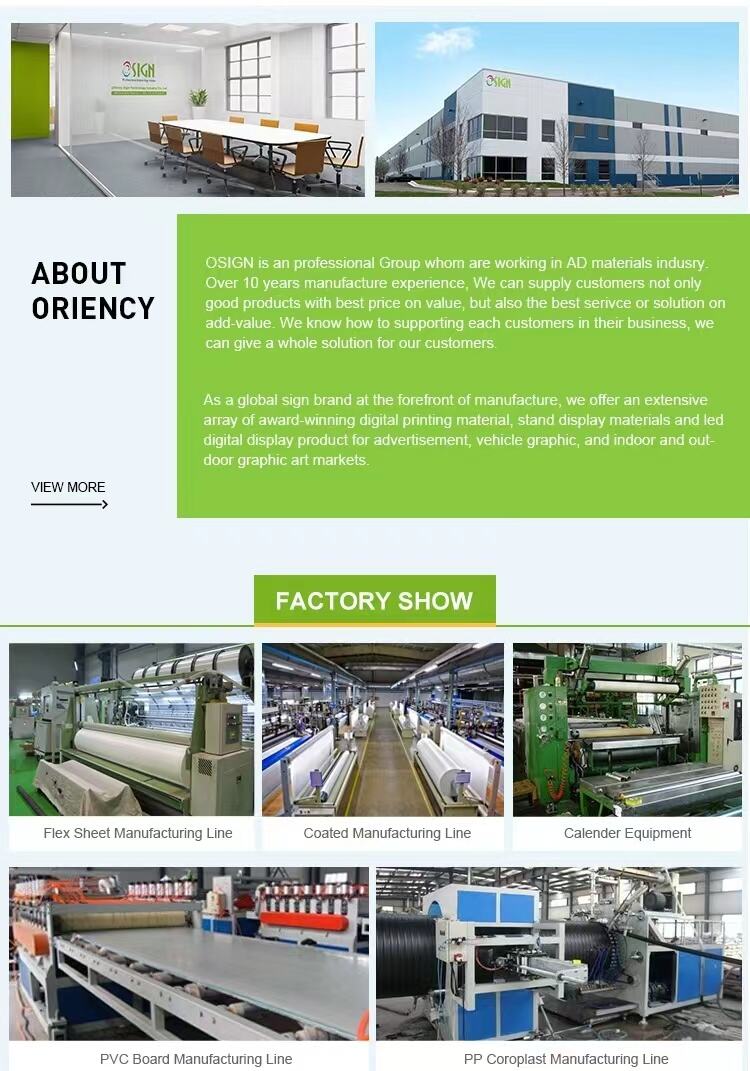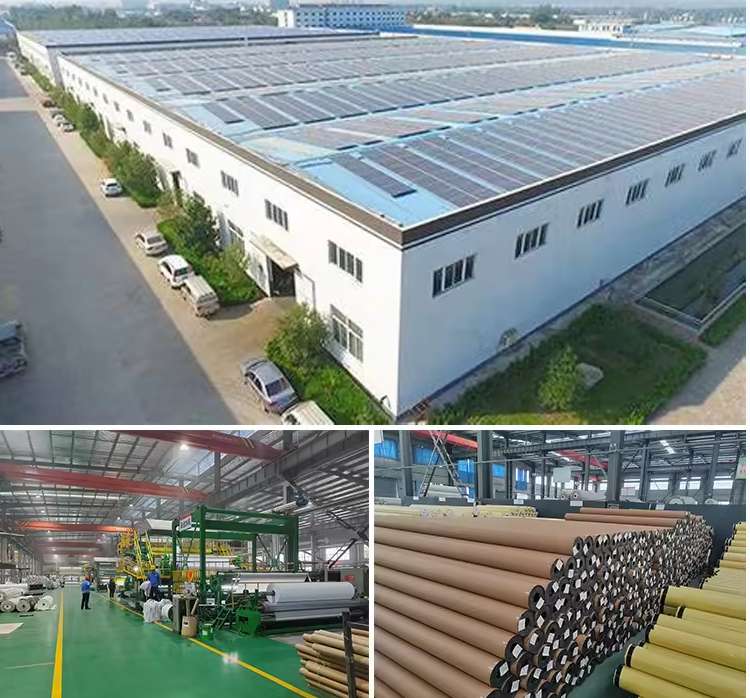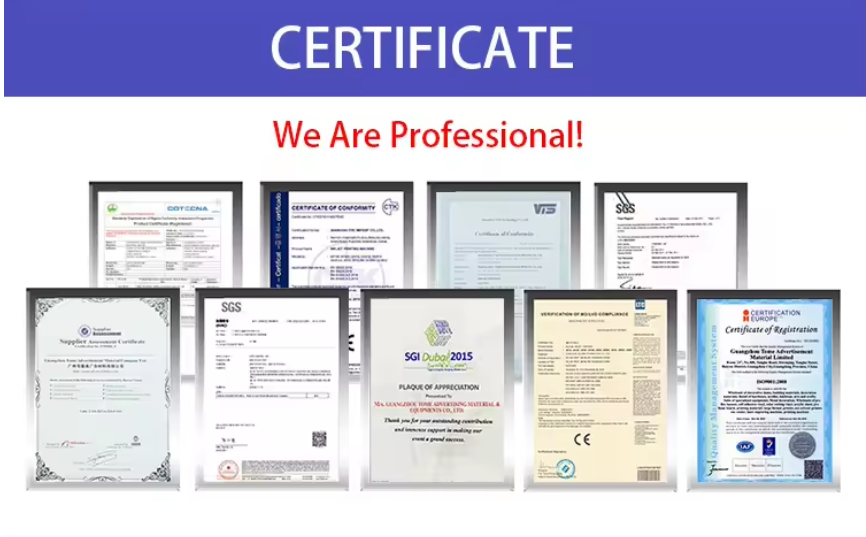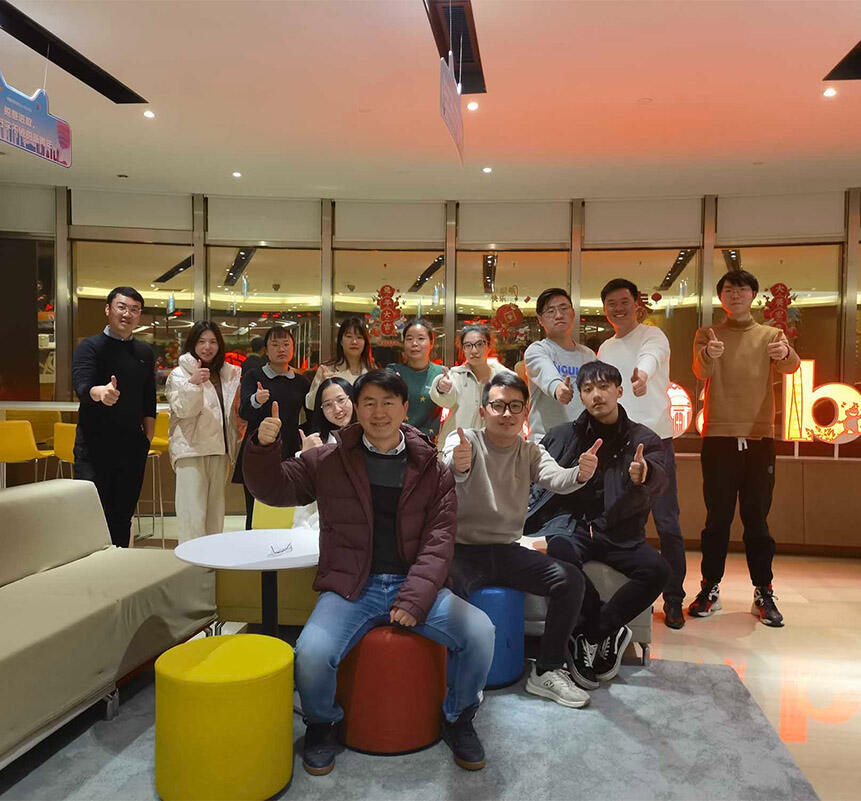|
Produkt
|
banner
|
|
Herkunftsland
|
shanghai
|
|
Marke
|
OSIGN
|
|
Material
|
PVC
|
|
Anwendung
|
Reklametafeln (Frontlit), Messestanddekoration, Displays (innen und außen), Gebäudemurale und In-Store-Displays.
|
|
Länge
|
50m oder nach Bedarf
|
|
Weite
|
1--3,2M/5M
|
|
Gewicht
|
240gsm, 260gsm, 300gsm, 340gsm, 400gsm, 440gsm, 510gsm, 550gsm, 610gsm sind beliebt
|
|
Garn
|
200*300D/300*500D/500*500D/500*1000D/1000*1000D
|
|
Oberfläche
|
Glossy/Matte/Halbglanz/Halbmatte verfügbar
|
|
Farbe
|
Weiß/Weiß; Weiß/Schwarz; Weiß/Grau verfügbar
|
|
Kompatibles Tintensystem
|
Lösungsmittel, Eco-Lösungsmittel, UV & Latex-Druck
|
|
TECHNOLOGIE
|
beschichtet / laminert
|
|
Verpackung
|
Kraftpapier / fester Rohr
|
|
MOQ
|
Im Durchschnitt: 3000qcm, ca. 30 Rollen; Der Preis wird je nach genauer Menge variieren, eine volle Containerladung wird billiger sein
|
|
Muster
|
verfügbar
|
| Autobeschichtungsvinyl: Polymeric Serie, 5-7 Jahre | ||||
| Artikel Nr. | oberfläche | Filmstärke | Größe | Kleber |
| OV3085-air | Glänzend oder matt | 60 Mikron PVC-Folie | 1,37M/1,52M | Grau, abnehmbar, Polyacryl |
| OLA600 | Glänzend oder matt | 60 Mikron PVC-Folie | 1,37M/1,52M | Klar, Polyacryl |
| Langfristig: Polymeric Serie, 3-5 Jahre | ||||
| Artikel Nr. | oberfläche | Filmstärke | Liner | Kleber |
| OV1133 | Glänzend oder matt | 80 Mikron PVC-Folie | 140g/m2 CCK | Klar, entfernbar, Polyacryl |
| OV3133 | 140g/m2 CCK | Grau, abnehmbar, Polyacryl | ||
| OV1133-air | CCK (Luftkanal) | Klar, entfernbar, Polyacryl | ||
| OV3133-air | CCK (Luftkanal) | Grau, abnehmbar, Polyacryl | ||
| Mittel-fristig: Monomere Serie, 2-3 Jahre | ||||
| Artikel Nr. | oberfläche | Filmstärke | Liner | Kleber |
| OV1132 | Glänzend oder matt | 100 Mikron PVC-Folie | 140g/m2 CCK | Klar, entfernbar, Polyacryl |
| OV2132 | 140g/m2 CCK | schwarz, entfernbar, Polyacryl | ||
| OV2132 | 140g/m2 CCK | grau, entferbar, Polyacryl | ||
| Wirtschaftliche Serie: Monomere Serie, 1 Jahr | ||||
| Artikel Nr. | oberfläche | Filmstärke | Liner | Kleber |
| OV1101E | Glänzend oder matt | 70 Mikron PVC-Folie | 100g/m2 Silikonpapier | Klar, Dauerhaft, Polyacryl |
| OV1101 | 80 Mikron PVC-Folie | 120g/m2 Silikonpapier | Klar, Dauerhaft, Polyacryl | |
| OV1131 | 100 Mikron PVC-Folie | 140g/m2 Silikonpapier | Klar, entfernbar, Polyacryl | |
| OV2131 | 140g/m2 Silikonpapier | schwarz, entfernbar, Polyacryl | ||
| OV3131 | 140g/m2 Silikonpapier | grau, entferbar, Polyacryl | ||
| OV1131-air | 140g/m2 Luftkanal | Klar, entfernbar, Polyacryl | ||
| OV1131-2M | 140g/m2 Silikonpapier - 2M großes Format | klar, entfernbar, Polyacryl | ||
| Spezielle Vinyls | ||||
| Artikel Nr. | oberfläche | Filmstärke | Liner | Kleber |
| OV1131 - Super Glanz | Glänzend oder matt | 100 Mikron PVC-Folie | 140g/m2 CCK | Klar, entfernbar, Polyacryl |
| OV1131 - Hochadhäsion | 140g/m2 CCK | schwarz, entfernbar, Polyacryl | ||
| OV1131 - HochOpaque | 140g/m2 CCK | grau, entferbar, Polyacryl | ||
Fahrzeugverkleidung - Einführung
Übersicht:
Fahrzeugverkleidung ist eine Vinylfolie, die zum Bedecken eines Fahrzeugs verwendet wird ’seiner Außenoberfläche. Sie ist darauf ausgelegt, das Originallackierung des Autos zu schützen und gleichzeitig ein neues, einzigartiges ästhetisches Erscheinungsbild zu bieten. Fahrzeugverkleidungen werden oft für Werbung, individuelle Designs und Farbänderungen ohne die Dauerhaftigkeit einer Lackierung verwendet. Die Folie ist in verschiedenen Farben, Texturen und Oberflächenzuständen erhältlich, einschließlich matt, glanz und satte.
Anwendungen:
Fahrzeugwerbung: Fahrzeugverkleidungen werden häufig für Flottenfahrzeuge, Taxis und Lieferwagen verwendet, um Marken, Produkte und Dienstleistungen zu werben.
Anpassung & Individualisierung: Autofreunde verwenden oft Verkleidungen, um das Aussehen ihrer Fahrzeuge anzupassen, einschließlich Farbänderungen, einzigartiger Grafiken und Designs.
Schutz & Erhalt: Fahrzeugverkleidung schützt die ursprüngliche Lackierung des Autos vor Kratzern, Spritzern, UV-Strahlen und Umwelteinwirkungen.
Temporäre Designs: Ideal für kurzfristige Werbeveranstaltungen, Autoschauen oder Sponsoring, bei denen temporäre Fahrzeuggrafiken benötigt werden.
Herstellungsverfahren:
Oberflächenvorbereitung: Das Fahrzeug muss gründlich gereinigt und dekontaminiert werden, um Schmutz, Staub oder Fett zu entfernen und sicherzustellen, dass die Umhüllung richtig anhaftet.
Entwurf: Das Design wird mit Hilfe einer Software digital erstellt, die dann an die genauen Abmessungen des Fahrzeugs angepasst wird.
Druck: Auf dem Vinylfilm werden mit Hilfe digitaler Drucktechnik hochauflösende Grafiken, Logos oder Designs gedruckt.
Schneiden: Das gedruckte Vinyl wird in die für jedes Fahrzeugteil erforderliche Form und Größe geschnitten.
Anwendung: Der Film wird auf das Fahrzeug aufgetragen. ’die Oberfläche wird in Abschnitten aufgeschnitten, sorgfältig erhitzt und gestreckt, um eine glatte, blasenfreie Anwendung zu gewährleisten. Die Kanten sind versiegelt, um zu verhindern, dass sie abschälen.
Vorteile:
Anpassung: Bietet unbegrenzte Gestaltungsmöglichkeiten mit einer Vielzahl von Farben, Texturen und Oberflächen, die den persönlichen oder geschäftlichen Bedürfnissen entsprechen.
Schutzschicht: Bietet einen Schutz gegen UV-Strahlen, Kratzer, Schmutz und Umwelteinflüsse, wodurch das Auto geschützt wird. ’ursprüngliche Lackierung.
Kostengünstig: Preismäßig günstiger als eine vollständige Lackierung, insbesondere bei komplexen Designs oder Farbänderungen.
Entfernbarkeit: Autobeschläge können entfernt werden, ohne die darunter liegende Lackierung zu beschädigen, was ideal für Leasingfahrzeuge oder temporäre Werbung ist.
Haltbarkeit: Hochwertige Beschläge können mehrere Jahre halten und bieten langfristigen Schutz sowie ästhetischen Reiz.
Vorsichtsmaßnahmen für die Anwendung:
Richtige Oberflächenvorbereitung: Stellen Sie sicher, dass das Fahrzeug vor der Anbringung des Beschlags gereinigt und frei von jeglichen Verunreinigungen ist, um Haftprobleme zu vermeiden.
Wetterbedingungen: Vermeiden Sie das Beschlagen in Extremwetterbedingungen wie hoher Feuchtigkeit, starkem Regen oder extremer Hitze, um eine ordnungsgemäße Haftung zu gewährleisten.
Wartung: Reinigen Sie das beschlagene Fahrzeug regelmäßig mit sanften, nicht abrasiven Reinigungsmitteln, um den Beschlag nicht zu beschädigen oder seine Lebensdauer zu verkürzen.
Vermeiden Sie Hochdruckreiniger: Hochdruckreiniger können den Beschlag beschädigen, daher ’es ist am besten, das Fahrzeug mit einem weichen Tuch oder einer Schwamm zu waschen.
Professionelle Installation: Es wird empfohlen, das Folienkleid von Profis installieren zu lassen, um die bestmöglichen Ergebnisse zu erzielen und Probleme wie Blasen oder Falten zu vermeiden.



Verwandt

Unser freundliches Team freut sich auf Ihre Nachricht!

Urheberrecht © OSIGN Alle Rechte vorbehalten - Datenschutzrichtlinie-Blog